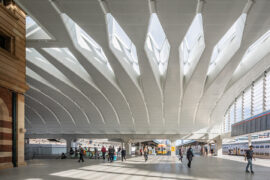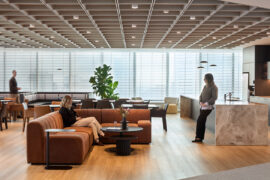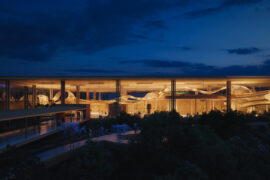Hassell recently presented its gigantic Metro Tunnel Project at the World Architecture Festival (WAF) alongside collaborators Weston Williamson and RSHP. We spoke to Hassell principal Ingrid Bakker about the scale of the work and what’s driving the design.

Town Hall Station - City Square, all images concept only.
December 18th, 2023
Timothy Alouani-Roby: Metro Tunnel is an enormous project – how do you go about the initial stages of comprehending its scale, factoring in all the different considerations and coming up with a coherent big-picture approach?
Ingrid Bakker: The Metro Tunnel will change the way we move around Melbourne, unlocking new parts of our city and new ways of engaging with those places we love today. While the Metro Tunnel reflects global best practice transport planning, it’s also uniquely Melbourne.

The project will deliver a legacy of outstanding stations and precincts. The architecture embraces natural light and openness – reflecting our city’s playful spirit and civic pride. The designs reflect and amplify unique qualities of each place and celebrate craft and detail. Embedded artworks will reveal local stories, values and connections.
The overarching design approach is underpinned by a number of key drivers:

How important are biophilic considerations?
It was a big emphasis in the architectural brief but the reality is the designs are more about embracing the best aspects of nature, such as fresh air and daylight and incorporating them into the station designs rather than simply mimicking nature.
How does your approach differ from the way a similarly large infrastructure project might have been understood in the past?
Melbourne hasn’t had a project of this scale for a very long time. There has been a lot of sensitivity in terms of how each station is integrated into the existing fabric of the city, how each design respects the surrounding heritage buildings and how important it’s been to engage with different stakeholders from Traditional Owners to universities, hospitals and the City of Melbourne.
In terms of heritage we’ve been particularly sensitive. At Anzac Station, for example, we integrated light canopies so as not to impact on the shrine and the boulevard.
Related: Talking to Kerstin Thompson at WAF 2023

How important is the exposure at WAF and how does this Australian infrastructure project compare with trends internationally?
As an international design firm, it’s important to showcase our Australian projects on a global stage such as WAF.
The five stations are very generous with a lot of attention to design detail. Compared to places like Singapore, where station design is quite modest, the stations and surrounding landscape design for Melbourne’s Metro Tunnel Project make a statement. The decision to provide generous, open designs was quite a conscious one.
Melbourne’s five new Metro Tunnel stations are a collaboration between international design practices Hassell, Weston Williamson and RSHP as part of the CYP D&C Joint Venture.
Hassell
hassellstudio.com

We think you might also like this story on Nightingale Village in Melbourne.
INDESIGN is on instagram
Follow @indesignlive
A searchable and comprehensive guide for specifying leading products and their suppliers
Keep up to date with the latest and greatest from our industry BFF's!

London-based design duo Raw Edges have joined forces with Established & Sons and Tongue & Groove to introduce Wall to Wall – a hand-stained, “living collection” that transforms parquet flooring into a canvas of colour, pattern, and possibility.

CDK Stone’s Natasha Stengos takes us through its Alexandria Selection Centre, where stone choice becomes a sensory experience – from curated spaces, crafted details and a colour-organised selection floor.

The World Architecture Festival has named The Holy Redeemer Church and Community Centre of Las Chumberas in La Laguna, Spain as World Building of the Year 2025, alongside major winners in interiors, future projects and landscape.

The Minns Labor Government has unveiled nine new architect-designed mid-rise apartment patterns, expanding the NSW Housing Pattern Book and accelerating the delivery of accessible, high-quality housing across the state.
The internet never sleeps! Here's the stuff you might have missed

COX Architecture and Yerrabingin reveal the design for Canberra Lyric Theatre — a world-class, inclusive venue for the nation’s capital.

The Australian Institute of Architects has unveiled 43 projects representing the pinnacle of contemporary design, with winners addressing housing, climate and affordability crises through innovative solutions.

GroupGSA delivers MUFG Pension & Market Service’s Sydney HQ with a dual Japanese–Australian identity, blending precision, warmth and workplace flexibility.

Recognised as winners at the INDE.Awards 2025, Enter Projects Asia in collaboration with SOM have received The Influencer award. Their work on Terminal 2 Kempegowda International Airport Interiors redefines the aesthetics of airport design through a monumental expression of biophilia, sustainability and craftsmanship.